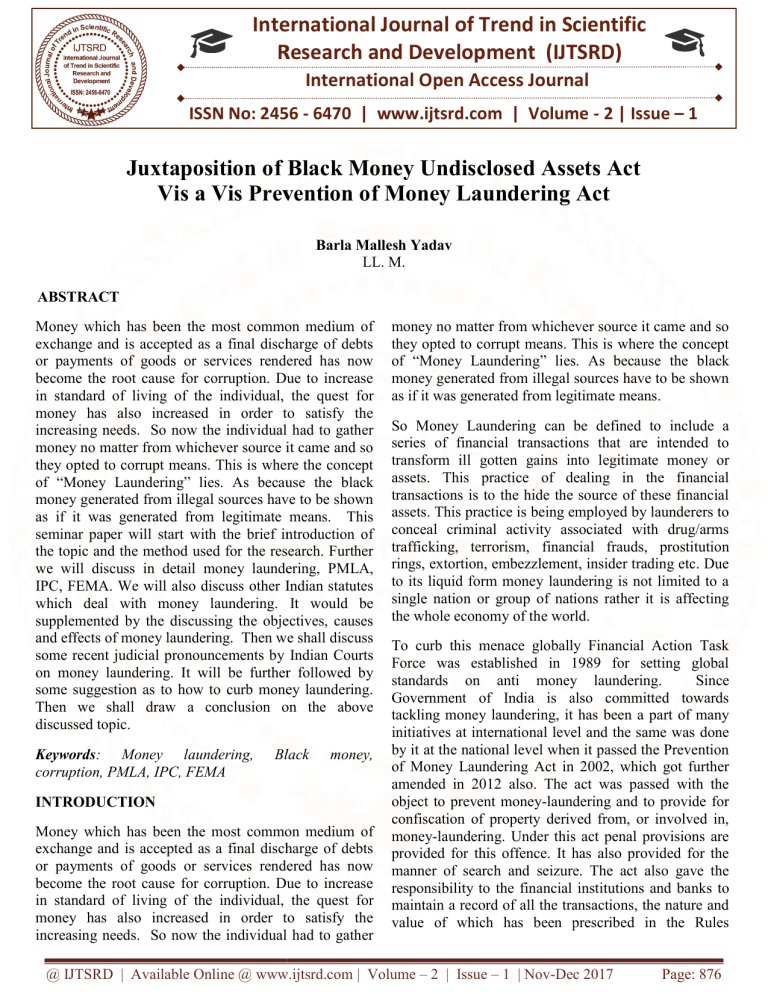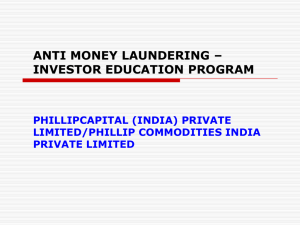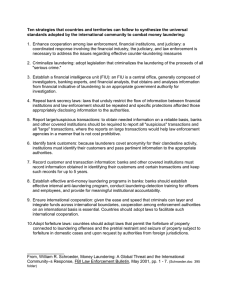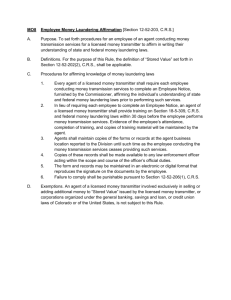
International Journal of Trend in Scientific
Research and Development (IJTSRD)
International Open Access Journal
ISSN No: 2456 - 6470 | www.ijtsrd.com | Volume - 2 | Issue – 1
Juxtaposition off Black Money Undisclosed Assets Act
Vis a Vis Prevention ooff Money Laundering Act
Barla Mallesh Yadav
LL. M.
ABSTRACT
Money which has been the most common medium of
exchange and is accepted as a final discharge of debts
or payments of goods or services rendered has now
become the root cause for corruption. Due to increase
in standard of living of the individual, the quest for
money has also increased in order to satisfy the
increasing needs. So now the individual had to gather
money no matter from whichever source it came and so
they opted to corrupt means. This is where the concept
of “Money Laundering” lies. As because the black
money generated from illegal sources have to be shown
as if it was generated from legitimate means. This
seminar paper will start with the brief introduction of
the topic and the method used for the research. Further
we will discuss in detail money
ney laundering, PMLA,
IPC, FEMA. We will also discuss other Indian statutes
which deal with money laundering. It would be
supplemented by the discussing the objectives, causes
and effects of money laundering. Then we shall discuss
some recent judicial pronouncements
nouncements by Indian Courts
on money laundering. It will be further followed by
some suggestion as to how to curb money laundering.
Then we shall draw a conclusion on the above
discussed topic.
Keywords:: Money laundering,
corruption, PMLA, IPC, FEMA
Black
money,
INTRODUCTION
Money which has been the most common medium of
exchange and is accepted as a final discharge of debts
or payments of goods or services rendered has now
become the root cause for corruption. Due to increase
in standard of living of the individual, the quest for
money has also increased in order to satisfy the
increasing needs. So now the individual had to gather
money no matter from whichever source it came and so
they opted to corrupt means. This is where the concept
of “Money Laundering” lies. As because the black
money generated from illegal sources have to be shown
as if it was generated from legitimate means.
So Money Laundering can be defined to include a
series of financial transactions that are intended to
transform ill gotten gains into legitimate
l
money or
assets. This practice of dealing in the financial
transactions is to the hide the source of these financial
assets. This practice is being employed by launderers to
conceal criminal activity associated with drug/arms
trafficking, terrorism,
sm, financial frauds, prostitution
rings, extortion, embezzlement, insider trading etc. Due
to its liquid form money laundering is not limited to a
single nation or group of nations rather it is affecting
the whole economy of the world.
To curb this menace globally Financial Action Task
Force was established in 1989 for setting global
standards on anti money laundering.
Since
Government of India is also committed towards
tackling money laundering, it has been a part of many
initiatives at international
al level and the same was done
by it at the national level when it passed the Prevention
of Money Laundering Act in 2002, which got further
amended in 2012 also. The act was passed with the
object to prevent money-laundering
laundering and to provide for
confiscation of property derived from, or involved in,
money-laundering.
laundering. Under this act penal provisions are
provided for this offence. It has also provided for the
manner of search and seizure. The act also gave the
responsibility to the financial institutions and banks
ba
to
maintain a record of all the transactions, the nature and
value of which has been prescribed in the Rules
@ IJTSRD | Available Online @ www.ijtsrd.com | Volume – 2 | Issue – 1 | Nov-Dec
Dec 2017
Page: 876
International Journal of Trend in Scientific Research and Development (IJTSRD) ISSN: 2456-6470
notified under the PMLA and also detailed information
relating to it such as identity of the client. In this project
we will discuss the roles of these financial institutions
and the features of the PMLA along with the current
judgements of the Supreme Court on this issue.
Legal Position in India
Though there were few statutes which insufficiently
dealt with money laundering, but due to increasing
number of cases a full-fledged statute was needed to
prevent this practice. So the Parliament enacted a
legislation known as Prevention of Money Laundering
which came into force from 1st July, 2005. The act in
Section 3 defined the term money laundering Section 3
as an offence done by party or entity which is directly
or indirectly linked with activities like concealment,
acquisition, possession, and use in the procedure of
proceeds of crime and projects an untainted property,
such party entity shall be guilty of money laundering.
Section 4 provides for punishment for the offence. A
rigorous imprisonment of 3 to 7 years has been
prescribed. The upper limit of fine which was fixed at 5
Lakhs Rupees has been removed by the amendment of
2012.
Section 5 deals with attachment of property which has
been illegally obtained for a maximum period of 180
days. There is also a provision of adjudicating
authorities under Section 8 which shall hear the cases
relating to the offence. The Central Government under
Section 9 has been vested with total rights free from all
encumbrances of all the confiscated property. Section
10 provides for the management of the sequester
property.
Since in the offence of money laundering the role of
banks and financial institutions is very critical,
therefore the act has prescribed an obligations on the
bank, financial institutions and intermediaries to
maintain certain records detailing the nature and value
of the transaction as prescribed under the act and also to
verify and maintain the records of the identity of all its
clients and also to verify the records of the clients from
time to time (Section 12).
The act also provides for the power of search and
seizure. The search can be carried out in the premises
where there is reason to believe that the offence of
money
laundering has been committed (Section 16).
There can also be seizure of the records or property
found relating to money laundering (Section 17). The
authorities have been also entrusted with the power to
arrest (Section 19). The authorities authorising the
search and seizure and those asking for production of
documents and evidences have been entrusted all the
power of the civil court as provided under the civil
procedure code.
The other provisions of the act provide for
establishment of Appellate tribunal to hear appeals
against the order passed by the adjudicating authority or
by director of FIU-IND (Chapter VI), Special Courts
to try the offences punishable under the Act (Chapter
VII), Adjudicating Authorities essentially to confirm
attachment or order confiscation of attached properties
under the act (Chapter VIII), Reciprocal arrangement
for assistance in certain matters (Chapter IX) and
Miscellaneous provisions (Chapter X). The Act
contains a total of 75 sections, and a Schedule, and it
imposes a good deal of responsibility upon financial
institutions.
Some of the other features include:
Reverse Burden of Proof:
As per the act the burden of proof in the case of money
laundering would be on the accused, which shall be
bound to prove that the money generated or gathered
has been done from a legitimate source rather than from
any criminal activity.
Scheduled Offences:
The act specifically lists down the two classes of
offences under the Schedule. This Schedule is divided
into two parts A and B. This division is on the basis of
the seriousness of the offence and the amount of money
involved. Like the offences against the State and
relating to Drug fall under Part A. In this punishment
can be of 3-7 years. However it can extend to 10 years
also.
For the offences listed under Schedule B a floor limit of
30 lakhs has been set. This floor limit has been set so as
to exclude small offences and properties. But
unfortunately this same limit has provided for the
escape route also, as now people deal in slightly lower
limit that which is fixed.
Coordination with other nations:
One of the most outstanding features of the PMLA is
that it allows the Central Government to enter into
agreement with other nations for the proper of
exchange of information relating to the customer and
also the verification of the same. The agreement would
also help in the proper enforcement of the provisions of
@ IJTSRD | Available Online @ www.ijtsrd.com | Volume – 2 | Issue – 1 | Nov-Dec 2017
Page: 877
International Journal of Trend in Scientific Research and Development (IJTSRD) ISSN: 2456-6470
the PMLA and which will at last help in preventing
money laundering.
Narcotic Drugs and Psychotropic Substances Act,
1985:
Position of NGOs:
This was one of the major statutes which addressed
money laundering. Under this act huge power was
given to the authority concerned. The authorities could
seize any account if they had suspicion on the nature of
transaction on the ground of illegal generation. They
were bound to maintain and record detailed information
and provide the same to the government.
The present Act has also covered NGOs under its
ambit. Earlier the politicians and the rich people used to
form an Ngo or any similar organisation and they
would easily convert their black money into white. But
now after the passing of this act, these organisations
have also to maintain of the financial transaction they
have gone through. Thus now if any such organisation
receives any donation also it has to maintain record
relating to it. And if there arises any suspicion, the
concerned authorities can conduct scrutiny of the
records also. As because the aim of the act is not just
only to cover income illegally generated but also to
inquire into those which have been concealed from the
public authorities.
Nature of the offences under the Act:
The offences under the Act shall be cognizable and
non-bailable.
Upper limit of fine
There is no upper limit of fine and the amount of fine
shall be decided by the court from cases to cases basis
and the same shall be depending on the gravity of the
offence. Earlier there was an upper limit of fine of Rs. 5
lakhs but the same has been deleted by the Amendment
Act of 2012.
Other Statutes relating to money laundering:
Before the passing of the PMLA, there were some other
statutes also which addressed with the issue of money
laundering though insufficiently. Some of those statutes
are:
Indian Penal Code, 1860:
Though this Act didn’t directly use the term money
laundering but then also it dealt with the offences of the
like nature. For e.g. it covered the offences relating to
fraud, property, transfer of deed, counterfeiting,
cheating etc.
The
Smugglers
and
Foreign
Exchange
Manipulations (Forfeiture of Property) Act, 1976:
This Act basically tried to prevent the illegal
acquisition of the property by the smugglers and the
foreign exchange manipulators. It also covered issues
covered under the Customs Act, 1962.
Financial Action Task Force (FATF):
In order to curb the menace of money laundering, India
became the 34 member of the FATF in the year 2010.
By becoming a member India strengthens the level of
coordination with other international organisation or
institutions to prevent money laundering and terrorism
financing. Not only this, the member nations should
share information relating to verification of any
customer and to report the same to the concerned in
case of any suspicious transaction.
FEMA (Foreign Exchange Management Act), 1999:
This act was brought after repealing FERA. The PMLA
act has close link with FEMA as violations and
prosecutions under both the statutes fall under
Enforcement Directorate which does the investigation
and attachment of assets involved.
Apart from the above statutes, there are other statutes
also which addressed the issue of money laundering
though only scantily. Some of them are: The Income
Tax Act, 1961; The Benami Transactions
(Prohibition) Act, 1988; Code of Criminal
Procedure, 1973.
We also have guidelines issued by SEBI and IRDA to
discourage the offence of money laundering and also to
identify the illegal transaction and also to stop the
insurance companies in hiding or conversion of black
money into white by the use of insurance policies.
These guidelines are in conformity with the PMLA.
The SEBI guidelines also deal with preventing funds
used for aiding terrorist activities. It also covers issues
such as how records are to be maintained and
verification of the clients and also to take note of any
suspicious transactions and to monitor such transaction.
The records of the clients are to be maintained for a
period of 10 years and the same to be verified and
updated from time to time.
@ IJTSRD | Available Online @ www.ijtsrd.com | Volume – 2 | Issue – 1 | Nov-Dec 2017
Page: 878
International Journal of Trend in Scientific Research and Development (IJTSRD) ISSN: 2456-6470
Similarly the IRDA guidelines which are applicable
only on the insurance companies were brought to curb
the misuse of insurance policies. The guidelines require
the insurance companies to maintain records of the
clients and to keep a check on the clients in order to see
that there is no misuse of the policy and to scrutinise
the same if there arises any such misuse.
Role of Financial Intelligence Unit- India
Financial Intelligence Unit – India (FIU-IND) which is
a specialised government agency was set up by the
Government of India in the year 2004. The agency is an
independent body and is under the control of
Department of Revenue, Ministry of Finance and is
responsible collecting, analysing, and disseminating
information, particularly about suspicious financial
transactions.
The FIU-IND performs many functions such as
collection of information, analysing of information,
sharing of information and also to co-ordinate the
collection and sharing of information with other
intelligence units effective at national, global level so
as to prevent money laundering. The FIU-IND is not a
regulatory agency rather it has to work in close
coordination with RBI, SEBI, and IRDA and to gather
and share financial intelligence
The Director of the FIU-IND is empowered under the
PMLA to impose fine on financial institutions or
banking companies if the fail to observe the provisions
of the Act.
The three strategic objective of the FIU-IND to prevent
money laundering and terrorist financing are as under:
To prevent money laundering and other economic
offences.
Deterring
terrorism.
money
laundering
and
financing
Making strong the organisational capacity.
Causes of Money Laundering:
There are many causes of money laundering. One of the
most important is the lust of the individual to generate
huge money in less span of time. Other causes of
money laundering are:
Lack of proper legislation – Absence of
legislation to deal with money laundering provides
an opportunity to criminals.
Evasion of tax – One of the other causes behind
money laundering is to evade tax. This is generally
done by not showing the actual property and assets
possessed.
Conversion of money- Since in the offence of
money laundering black money is generated and
there is always threat of being caught, so the money
is converted into white .This is done to show that
money was generated from a legitimate source.
Effect of Money Laundering:
The effect of money laundering is very extensive. The
effect can also be for a very long term if the money
involved is large. Some of the most prominent effect of
money laundering is stated below:
It distorts capital and trade flow.
It increases corruption and provides a way to crime.
It destroys the reputation of the country or financial
institution.
It leads to evasion of tax.
Cases of Money Laundering in India:
B. Rama Raju s/o B. Ramalinga Raju vs. Union
Of India1
(Satyam Scam):
The Satyam scandal is one of the biggest corporate
frauds which took place in India. The company was
earlier considered as an ideal in the IT sector in terms
of profit making. The scam was about maintenance o
false records, practicing false audit. There was
concealment of basic information such as revenues,
profits which company earned, interests, liabilities.
The relevant information was hidden just to show that
the company is in good health and even the
independent directors were not given correct
information and were kept in dark as to the actual work
of the company. The scam was of over 8,000 crore and
it shocked the whole nation. The money earned through
the scam was used to purchase thousand acres of land
in Andhra Pradesh and also was used to purchase two
infrastructure companies.
The accused in the scam were charged under various
offences such as cheating, criminal conspiracy, and
forgery, breach of trust, faking accounts and violating
number of income tax laws. The Special CBI court
found Ramalinga Raju and nine other guilty of many
@ IJTSRD | Available Online @ www.ijtsrd.com | Volume – 2 | Issue – 1 | Nov-Dec 2017
Page: 879
International Journal of Trend in Scientific Research and Development (IJTSRD) ISSN: 2456-6470
offences and so it convicted all the accused.
Arun Kumar
Enforcement
Mishra
vs.
Directorate
Of
The case relates to five employees of Punjab National
Bank who are said to maintain five different fake
accounts in name of non-existent persons and using this
account for deposit and withdrawal purposes. By doing
this the five persons misappropriated the funds of PNB
from which they gained profit and in turn it leads to
loss to the concerned bank.
The above offence was committed in the year 2005 and
it is said that the offence is against the Section 13 of
Prevention of Corruption Act, Section 120B of Indian
Penal Code and Section 3 of the PMLA. However on
the applicability of PMLA it was argued that the
particular provision of the PMLA came into effect from
in the year 2009 and so it can’t be made applicable
retrospectively. Also Article 20(3) bars ex post facto
application of law.
On the basis of the arguments the court stated that
disposed of the case stating that it would be against Part
III of the Constitution. Hence the Directorate of
Enforcement is free to initiate fresh proceeding as per
the law thereafter if the offence of money laundering is
established against the accused.
CONCLUSION
Money Laundering is a global challenge and it has
changed the nature of business around the world. Many
initiatives have been taken to curb this menace both at
international and national level. However in the
implementation of these laws sometimes innocent
business get into trap and suffer the trouble. The effect
of money laundering is sometimes so harsh that it can
become the reason for economic instability of a
country.
This research has dealt with the legal aspect of money
laundering at the national level along with the
international aspect and has tried to scrutinise that how
effective these legislations have been to curb the this
menace and prevent money laundering and terrorism
financing.
money laundering. However if there comes a uniform
international law to deal with money laundering, then it
would become hard for launders to escape and at the
same time it would also become easy to prevent money
laundering. With this type of concerted efforts from all,
we can hope to put a check and prevent money
laundering.
REFERENCES
Books:
1. Handbook of Anti-Money Laundering by Dennis
Cox
2. Money Laundering: A Guide
Investigator by John Madinger
for
Criminal
3. The black economy in India by Arun Kumar
E-Sources:
1.
2.
3.
4.
www.anti-moneylaundering.org
www.rbi.org.in
www.sebi.gov.in
www.bankersacedmy.com
Articles:
1. Laundering the Proceeds of Corruption – FATF
Report (July, 2011)
2. Hand Book on the Prevention of Money Laundering
Act, 2002 by CA Rajkumar S. Adukia
3. Controlling Money Laundering in India – Problems
and Perspectives by Vijay Kumar Singh
4. Prevention of Money Laundering Act, 2002 – An
Overview by Binod Poddar and Shalini Singh
5. Combating India’s heroin Trade through anti money
laundering legislation- An article by Kavita
Natrajan
6. India’s initiatives to Curb and Unearth Black
Money and Tax Evasion – A Press Release by
Ministry of Finance
In India though we have a specific law dealing with
money laundering but it should be implemented in its
spirit also. The Act contains provisions dealing with
nearly all the aspects required to prevent the offence.
But there should be regular amendment in it so that it is
able to deal with the new methods adopted to commit
@ IJTSRD | Available Online @ www.ijtsrd.com | Volume – 2 | Issue – 1 | Nov-Dec 2017
Page: 880








